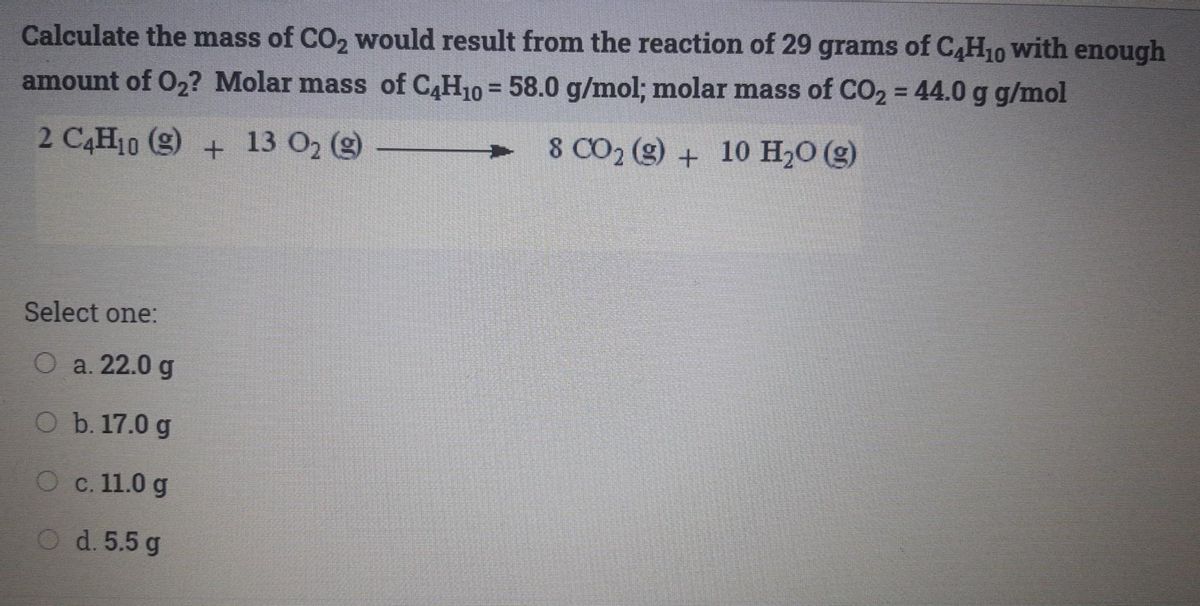
And don’t forget to put the unit g/mol to your final calculated molar mass.First solve the brackets, then multiplications and at last do the final addition. Always follow the calculation order to avoid any mistakes in calculation.But all these units (i.e g/mol, grams/mole and g/mole) are the same. In some books, you may see the unit of molar mass as grams/mole or g/mole.I hope you have understood the short and simple calculation for finding the molar mass of CO2. Hence the Molar mass of CO2 is 44.009 g/mol. So, Molar mass of CO2 = Molar mass of 1 Carbon (C) atom + Molar mass of 2 Oxygen (O) atoms. You can see that in CO2, there is 1 Carbon atom and 2 Oxygen atoms. combustion at SLC (25 C and 100 kPa) with combustion products being CO2 and H2O. Add them together to get the total molar mass of 18.013 g/mol.Now, to calculate the molar mass of CO2, you just have to add the molar mass of all the individual atoms that are present in CO2. In this case, the molar mass of the two hydrogen atoms is 2.014 g/mol, while the single oxygen atom is 15.999 g/mol. Don’t forget to take into account the number of atoms of each element when you make your calculation. Then, calculate the molar mass of each element in the compound. Molecular formula: CO 2 Elements: Carbon (C), Oxygen (O) Molecular weight: 44.009 g/mol Molar volume: 23. For example, if you’re calculating the molar mass of water, you’d start with the formula H2O. First, you’ll need to find the chemical formula for the compound. Finding the molar mass of a compound is a little more complicated. For example, the molar mass of H2 is 1.007 x 2 x 1 g/mol, or 2.014 g/mol. In these cases, you’ll need to multiply the relative atomic mass of the element by the number of atoms in the molecule, then multiply the result by the molar mass constant. However, some elements, such as hydrogen, nitrogen, and oxygen, only occur naturally in molecules of 2 or more atoms. How many moles of LiOH are needed to react completely with 25.5 g of CO2 0.290 0.579 1.16 1.73 Click the card to flip Definition 1 / 10 1. CO2 + 2LiOH -> Li2CO3 + H2OT he molar mass CO2 is 44.01 g/mol. For instance, zirconium has a molar mass of 91.22 x 1 g/mol, or 91.22 g/mol. The chemical equation below shows the reaction between carbon dioxide (CO2) and lithium hydroxide (LiOH). For most elements, this means that the relative atomic mass is equal to the molar mass. Next, multiply the atomic mass by the molar mass constant, which is equal to 1 gram per mole. For instance, the relative atomic mass of zirconium (Zr) is 91.22. This is usually located under the symbol and name of the element. To find an element’s molar mass, start by checking the periodic table for the relative atomic mass of the element. Molar mass is the mass in grams of 1 mole of any given substance. According to the International System of Units, a mole is the amount of any substance that contains the same number of elementary entities-typically atoms or molecules-as there are atoms in 12 grams of the isotope carbon-12. When you’re measuring extremely tiny amounts of a substance, it can be helpful to use molar mass. How do you find the mass of CO2 produced We know that the reaction goes to completion, so all the methane will be reacted. Determine the amount of oxygen produced when 0.549 g of KClO3 decomposes. One mnemonic device for remembering diatomic elements (molecules of 2 atoms) is: Have No Fear Of Ice Cold Beverages (Hydrogen, Nitrogen, Fluorine, Oxygen, Iodine, Chlorine, Bromine). The molar mass of CO2 is 44.01 g/mol and the molar mass of propane is 44.09 g/mol.Multiply them by the molar mass constant, and then multiply the result by 2. This means that if you want to find the molar mass of elements that are composed of 2 atoms, such as hydrogen, oxygen, and chlorine, then you'll have to find their relative atomic masses. Summing these masses as 12 + 2 (16) gives 44 g/mol, meaning that there are 44 grams of CO2 in one mole of carbon dioxide. The CO2 formula means that carbon dioxide has one carbon atom (12 g/mol) and two oxygen atoms (16 g/mol each).

Some elements are only found in molecules of 2 atoms or more. You can find the molar mass of carbon dioxide by adding together the molar masses of its component atoms.This converts atomic units to grams per mole, making the molar mass of hydrogen 1.007 grams per mole, of carbon 12.0107 grams per mole, of oxygen 15.9994 grams per mole, and of chlorine 35.453 grams per mole.

This is defined as 0.001 kilogram per mole, or 1 gram per mole.

Multiply the relative atomic mass by the molar mass constant.


 0 kommentar(er)
0 kommentar(er)
